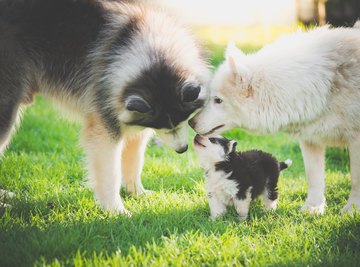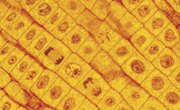
What does it mean to be alive? Apart from everyday philosophical observations like "an opportunity to contribute to society," most answers might take the form of the following:
- "Breathing air in and out."
- "A heartbeat."
- "Eating food and drinking water."
- "Responding to changes in the environment, like dressing for cold weather."
- "Starting a family."
While these seem like vaguely scientific responses at best, they actually reflect the scientific definition of life at the cellular level. In a world now rife with machines that can mimic the actions of humans and other flora and sometimes greatly exceed human output, it is important to examine the question, "What are the properties of life?"
Characteristics of Living Things
Different textbooks and online resources provide slightly different criteria for what properties constitute the functional characteristics of living things. For present purposes, consider the following list of attributes to be fully representative of a living organism:
- Organization.
- Sensitivity or response to stimuli.
- Reproduction.
- Adaptation.
- Growth and development.
- Regulation.
- Homeostasis.
- Metabolism.
These will each be explored individually after a brief treatise on how life, whatever it may be, likely got its start on Earth and the key chemical ingredients of living things.
The Molecules of Life
All living things consist of at least one cell. While prokaryotic organisms, which include those in the Bacteria and Archaea classification domains, are almost all unicellular, those in the Eukaryota domain, which includes plants, animals and fungi, typically have trillions of individual cells.
Although cells themselves are microscopic, even the most basic cell consists of a great many molecules that are far smaller. Over three-fourths of the mass of living things consist of water, ions and various small organic (i.e., containing carbon) molecules such as sugars, vitamins and fatty acids. Ions are atoms carrying an electrical charge, such as chlorine (Cl-) or calcium (Ca2+).
The remaining one-fourth of living mass, or biomass, consists of macromolecules, or large molecules made from small repeating units. Among these are proteins, which make up most of your internal organs and consist of polymers, or chains, of amino acids; polysaccharides, such as glycogen (a polymer of the simple sugar glucose); and the nucleic acid deoxyribonucleic acid (DNA).
Smaller molecules are usually moved into a cell according that cell's needs. However, the cell has to manufacture macromolecules.
The Origins of Life on Earth
How life got its start is a fascinating question for scientists, and not merely for the purpose of solving a wonderful cosmic mystery. If scientists can determine with certainty how life on Earth first kicked into gear, they might be able to more easily predict what foreign worlds, if any, are also likely to host some form of life.
Scientists do know that by about 3.5 billion years ago, a mere billion or so years after the Earth first coalesced into a planet, prokaryotic organisms existed, and that, like today's organisms, they probably used DNA as their genetic material.
It is also known that RNA, another nucleic acid, may have pre-dated DNA in some form. This is because RNA, in addition to storing information encoded by DNA, can also catalyze, or speed up, certain biochemical reactions. It's also single-stranded and slightly simpler than DNA.
Scientists are able to determine many of these things by looking at the molecular-level similarities between organisms that seemingly have very little in common. Advances in technology starting in the latter part of the 20th century have greatly expanded science's tool kit and offer hope that this admittedly difficult mystery may one day be definitively solved.
Organization
All living things show organization, or order. This essentially means that when you look closely at anything that is alive, it is organized in a way highly unlikely to occur in nonliving things, such as the careful partitioning of cell contents to prevent "self-harm" and allow for the efficient movement of critical molecules.
Even the simplest one-celled organisms contain DNA, a cell membrane and ribosomes, all of which are exquisitely organized and designed to carry out specific vital tasks. Here, atoms make up molecules, and molecules make up structures that stand apart from their environment in both physical and functional ways.
Response to Stimuli
Individual cells respond to changes in their internal environment in predictable ways. For example, when a macromolecule like glycogen is in short supply in your system thanks to a long bike ride you just completed, your cells will make more of it by aggregating molecules (glucose and enzymes) needed for glycogen synthesis.
At the macro level, some responses to stimuli in the the external environment are obvious. A plant grows in the direction of a consistent light source; you move to one side to avoid stepping in a puddle when your brain tells you it is there.
Reproduction
The ability to reproduce is one of the most persistently obvious traits of living things. The bacterial colonies growing on the spoiling food in a fridge represent the reproduction of micro-organisms.
All organisms reproduce identical (prokaryotes) or very similar (eukaryotes) copies of themselves thanks to their DNA. Bacteria can only reproduce asexually, meaning that they simply split in two to yield identical daughter cells. Humans, animals and even plants reproduce sexually, which ensures genetic diversity of the species and hence a greater chance of species survival.
Adaptation
Without the ability to adapt to changing environmental conditions, such as temperature shifts, organisms would not be able to maintain the fitness necessary for survival. The more an organism can adapt, the better the chance it will survive long enough to reproduce.
It is important to note that "fitness" is species-specific. Some archaebacteria, for example, live in near-boiling-hot thermal vents that would quickly kill most other living things.
Growth and Development
Growth, the manner in which organisms become larger and more different in appearance as they mature and engage in metabolic activities, is determined to an enormous extent by the information coded in their DNA.
This information, however, can provide different results in different environments, and the organism's cellular machinery "decides" what protein products to make in higher or lower quantities.
Regulation
Regulation can be thought of as the coordination of other processes indicative of life, such as metabolism and homeostasis.
For example, you can regulate the amount of air coming into your lungs by breathing faster when you exercise, and when you're unusually hungry, you can eat more to offset the expenditure of unusually high amounts of energy.
Homeostasis
Homeostasis can be thought of as a more rigid form of regulation, with the acceptable boundaries of "high" and "low" for a given chemical state being closer together.
Examples include pH (the level of acidity inside a cell), temperature and the ratio of key molecules to one another, such as oxygen and carbon dioxide.
This maintenance of a "steady state," or very close to one, is indispensable to living things.
Metabolism
Metabolism is perhaps the most striking moment-to-moment property of life you're likely to observe on an everyday basis. All cells have the ability to synthesize a molecule called ATP, or adenosine triphosphate, which is used to drive processes in the cell such as reproduction of DNA and protein synthesis.
This is made possible because living things can use the energy in the bonds of carbon-containing molecules, notably glucose and fatty acids, to assemble ATP, usually by adding a phosphate group to adenosine diphosphate (ADP).
Breaking down molecules (catabolism) for energy is just one aspect of metabolism, however. Building larger molecules from smaller ones, which reflects growth, is the anabolic side of metabolism.
References
About the Author
Kevin Beck holds a bachelor's degree in physics with minors in math and chemistry from the University of Vermont. Formerly with ScienceBlogs.com and the editor of "Run Strong," he has written for Runner's World, Men's Fitness, Competitor, and a variety of other publications. More about Kevin and links to his professional work can be found at www.kemibe.com.
